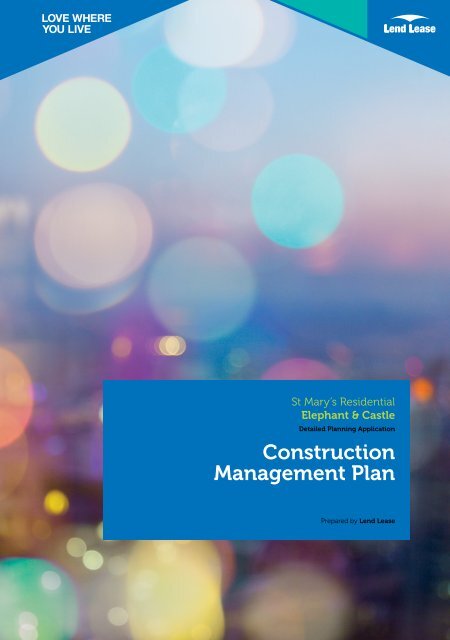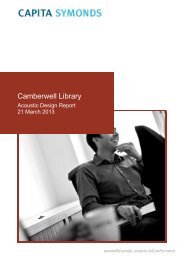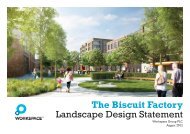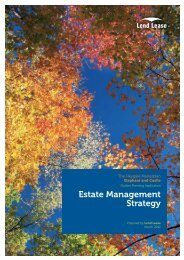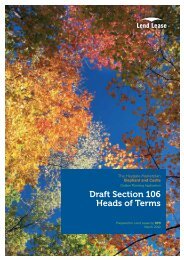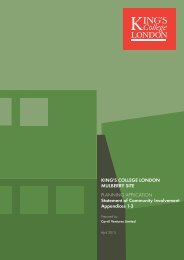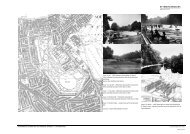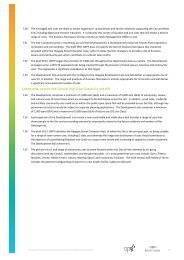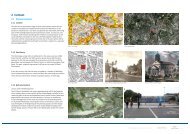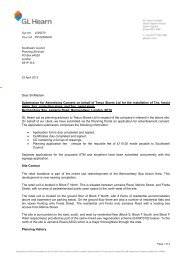Construction Management Plan - Southwark Council Planning Pages
Construction Management Plan - Southwark Council Planning Pages
Construction Management Plan - Southwark Council Planning Pages
- No tags were found...
You also want an ePaper? Increase the reach of your titles
YUMPU automatically turns print PDFs into web optimized ePapers that Google loves.
St Mary’s ResidentialElephant & CastleDetailed <strong>Plan</strong>ning Application<strong>Construction</strong><strong>Management</strong> <strong>Plan</strong>Prepared by Lend Lease
St Mary’s Residential will seta new benchmark in qualitydesign and sustainableinner city living.
St Mary’s ResidentialDetailed <strong>Plan</strong>ning Application<strong>Construction</strong> <strong>Management</strong> <strong>Plan</strong>Prepared by Lend LeaseJune 2012
Application Documents■■Covering Letter, Forms and Certificate■■<strong>Plan</strong>ning Application Drawings■■Design and Access Statement■■Landscape Strategy■■Environmental Statement• Main Text and FiguresκκChapter 1 IntroductionκκChapter 2 EIA MethodologyκκChapter 3 Existing Land Uses and ActivitiesκκChapter 4 Alternatives and Design EvolutionκκChapter 5 The Proposed DevelopmentκκChapter 6 Development Programme and <strong>Construction</strong>κκChapter 7 Socio-EconomicsκκChapter 8 Transportation and AccessκκChapter 9 Noise and VibrationκκChapter 10 Air QualityκκChapter 11 Ground Conditions and ContaminationκκChapter 12 Water Resources, Drainage and Flood Risk AssessmentκκChapter 13 EcologyκκChapter 14 ArchaeologyκκChapter 15 WindκκChapter 16 Daylight, Sunlight, Overshadowing and Solar GlareκκChapter 17 Cumulative ImpactsκκChapter 18 Summary of Residual Effects• Townscape, Visual and Built Heritage Assessment• Appendices• Non-Technical Summary■■<strong>Plan</strong>ning Statement■■Transport Assessment / Travel <strong>Plan</strong>■■Housing Statement■■Sustainability Strategy■■Waste Strategy■■<strong>Construction</strong> <strong>Management</strong> <strong>Plan</strong>■■Draft Section 106 Heads of Terms■■Energy Strategy■■Access Statement■■Statement of Community InvolvementSt Mary’s Residential Detailed <strong>Plan</strong>ning Application
Contents1 <strong>Construction</strong> <strong>Management</strong> <strong>Plan</strong>2 Enabling Works3 Infrastructure Works4 <strong>Construction</strong> Traffic & Access Site5 SiteLogistics6 Description of Works and <strong>Construction</strong>n Methods7 Safety, Health and Environmental Considerations During <strong>Construction</strong>8 Work Force9 Public Relations and Community Liaison10 Appendix A581113151821343739St Mary’s Residential Detailed <strong>Plan</strong>ning Application May 20124
1 <strong>Construction</strong> Manageement <strong>Plan</strong>1.1 IntroductionThis <strong>Construction</strong> <strong>Management</strong> <strong>Plan</strong> (CMP) has been prepared and submitted byy Lend Lease Residential(CG) PLC(Lend Lease), to support the planning application for the redevelopment of the St Mary’sResidential Site, Elephant and Castle (the “Site”).This CMPdescribes the anticipated construction programme for the Development and describes thenature of the activities to be undertaken concurrently with the new Leisure L Centre development. Itidentifies the environmental considerations associated with these activities and outlines appropriatemeasures that mightbe implemented for their mitigation.<strong>Plan</strong>ningfor the construction works may be subject to modification following f coordination with<strong>Southwark</strong> <strong>Council</strong> and 4Futures in regards to their commitment to deliver d a neww Leisure Centre locatedadjacentto the Site.This assessment has been made using the experience of Lend Lease and a their professional advisersbased onthe construction methods and contracting strategies that can be reasonably anticipated for adevelopment of this type.The footprint of the Site covers approximateely 0.56h (area of the red line boundary used in the ES) withthe requirement of a single Site compound c within the development area. a Due to the positioning of theSite, construction traffic routes and construction traffic will be closely monitoredd and limited.The target date assumed for thiss CMP for commencement of the works on Site iss from late Q2 2013. Thefirst activity will be provision for security gates along the Elephant and Castle elevation pendingagreement on pit lane access with the Highways Authority.<strong>Construction</strong> works for the Development hass potential toimpact the local environment and hastherefore been assessed as part of the Environmental Impact Assessment submitted with this <strong>Plan</strong>ningApplication. Health and safety issues will be addressed in a proactivee manner during the constructionphases. Any construction works to the public realm outside the Site boundary are to be agreed with<strong>Southwark</strong> <strong>Council</strong>.<strong>Construction</strong> management and planning, andd adoption of environmental best practices, goodneighbourhood policies and regular meetings with <strong>Southwark</strong> <strong>Council</strong>, including local stakeholders andcommunity engagement will contribute to mitigating adverse environmental effects and ensuring goodconstruction, environmental, health and safety practices.This CMPsets out a number of strategies, standards and procedures in order to mitigate anticipatedenvironmental impacts and ensure good Sitee health and safety practices.The issues that have been considered within this document are as follows:• <strong>Construction</strong> programme andphasing;• Infrastructure Works;• Description of Works;• Site Logistics;• Indicative <strong>Construction</strong> Methods;• Safety, health andenvironmental mitigation provisions;St Mary’s Residential Detailed <strong>Plan</strong>ning Application May 20125
• Workforce; and• Public relations and community liaison• <strong>Construction</strong> Programme & Phasing1.2 Assumed<strong>Construction</strong> Programme& PhasingAn assumed construction programme indicative start is included as Appendix A A of this document.A flexiblee approach to planning, logistics andd programming of the project will be required to incorporateboth thebest practise currently available andd future trade contractor inputThe demolition of the existing Leisure Centree will be completed by others commencing mid to late 2012and complete in 2013 and therefore is not considered further in this document.The Development is split into 4 constructionc phases and is further explained in section 6:• Substructure & Basement• Superstructure• Envelope, Shell & Core• Fit Out & External WorksActivitySubstructure and BasementSuperstructureeEnvelope, Roof, Shell and CoreFit‐out and External WorksTotal DurationApproximate Duration( months)7161518331.3 Building ConfigurationRedevelopment to provide a 37 storey s building (maximum building height h 127m AOD) and 4 storeypavilion building (maximum building height 20.5m AOD),comprising 284 residential units, 809 sqm(GEA) retail (A1‐A3), and 413 sqm(GEA) commercial (B1)uses, car parking, cycle parking, servicing andplant areas, landscaping and public realm improvementsand associated worksAt each phase of theDevelopment some or all of the following activities will be required:• Survey/recordingand subsequent demolition and removal of existing Leisure Centre foundations• Archaeological watching brieff (programme of monitoring and recording);• Condition survey of perimeter roads;• Unexploded ordnance survey;• Geotechnical investigation (soil type, contamination and ground conditions); c• Service infrastructure works e.g. abandonment, re‐routing and reinforcementt of the utility networks;• Tree protection works and ecological Sitee surveys (Aboricultural)St Mary’s Residential Detailed <strong>Plan</strong>ning Application May 20126
• Site clearance and enabling works, including earthworks to createe a suitable developmentt platform,and remediate if required;• Sub‐structure works i.e. pilingand foundations;• <strong>Construction</strong> of superstructure, envelopee and buildingfit out; andd• External works including landscaping and public realm.• Telecommunications, reception and interference survey• Connection to utilitiesSt Mary’s Residential Detailed <strong>Plan</strong>ning Application May 20127
2 EnablingWorks2.1 Asbestoss RemovalThe removal of asbestos identified in the ground o the existing Leisure Centre Site will be completed by4 Futures on behalf of <strong>Southwark</strong> <strong>Council</strong> prior to demolition commencing.2.2 DemolitionAs agreed with <strong>Southwark</strong> <strong>Council</strong>, the following demolition works will w be carriedd out but 4 Futures:• Demolish and remove from the Site any equipment, fixtures and fittings, chattels, all existingmechanical and electrical services and all building structures (excluding the building slab) down toground level and in the case of the swimming pool on the Site to the undersidee of the baseof theswimming pool ncluding any and all asbestos materials and otherr Hazardous Substances within theexisting building within the boundary of the Site;• Demolish and remove from the Site all incoming and outgoing public health services andtelecommunications to or fromthe existing building on the Site leaving them capped at the boundaryof theSite;• Demolish and remove from the Site all access ramps, egress ramps, handrails and any andall streetfurniture;• Handover the Site to the Tenant in a clear clean and safe condition together with a site clearancecertificate and survey information of any known remaining elements of substructure and known inground obstructions;It has therefore beenassumed that the removal of any deep footingss will be demolished andremovedby Lend Lease.2.3 Enabling WorksThe following pre‐commencement and enabling works activities to be carried out following vacantpossession of the Site from <strong>Southwark</strong> <strong>Council</strong> are to be confirmed.• Statutory notifications and consents, hoarding and scaffold licences, road closures (if required) etc;• Identification of methods andproceduress to comply with Section 61 of the Control of Pollution Act;1974 agreementsand consents;• Approval of method statements and risk assessments, scaffoldingg and temporary works designs;• If anyfurther demolition is equired following taking possession of o the Site, preparation of a writtenplan for carrying out the demolition in accordance with Regulation 29 of the CDM regulations toidentify how danger and risk from these activities willl be prevented;• Alteration and adaptation of site hoardingg originally provided by demolition d contractor• Service terminations / disconnections at the Site boundary by utility companies;• Supply and installation of Siteaccommodation & welfare facilities;• Installation of temporary power, lighting and water services;• Facilitation of tree pruning, tree removal and installation of tree protection p measures;• Establishment of fire escape routes r / systems & emergency plans; ; and• Early environmental clean of the properties, sharp needle sweep, hazardous material identificationand pest control within the Site boundary.• Removal of hazardous materialsSt Mary’s Residential Detailed <strong>Plan</strong>ning Application May 20128
2.4 HoardingIt is agreed that the 4 Futures/demolition contractors will be instructed to leave the Site enclosed withhoarding. In enclosing the Site, the boundaryy with the new Leisure Centre Site too the west off ourDevelopment shouldbe includedd in the samee solid hoarding. Hoarding design will follow the objectivesfor outdoor hoardings design guidelines from<strong>Southwark</strong><strong>Council</strong> as included in the Agreement for Lease.Separation of the two sites is essential to maintain the security and safety s management responsibilitiesof the two contractors.Security gates will berequired att the North West corner junction with Brook Drive/ Oswin Street. Thesetting out of this entrance and how it is shared with theadjoining Site should bee dimensioned toensure maximum turn around space for vehicles. Traffic marshalling and deliveryy management will beco‐ordinated between the two schemes.Security gates will berequired tothe Elephant & Castle elevation if Lend Lease iss successful in agreeing apit lane access with TFL. At present it has been assumed that these will w be addedd when Lend Lease takesover theSite and notprovided by the demolition contractor. Similarly a pedestrian gate will be added tosuit the final agreed position of main Site accommodation.2.5 Site AccommodationThe assumed location for Site accommodation is subject to reaching agreement with <strong>Southwark</strong> <strong>Council</strong>.Accommodation hasbeen sized for f the project averagingg 250 operatives daily and peaking att around350. Around 25 LendLease staff is expected. . . Site Accommodation will w comprise`:• Lend Lease Staff Offices for 25 plus meeting and admin space• Canteen to seat 150 with kitchen, serveryy and stores to suit• Drying room with400 lockerss (in tiers to save space)• M/F toilets, showers, and washing facilities• Security office• Induction RoomTotal space requiredfor the above is around 700m2 of modular space. Ideally this should be located atthe Site perimeter toallow Personal Protective Equipment (PPE) freee entry from the street with theminimumm of protected walkways.Site access will be controlled in accordance with Lend Lease security and safety protocols. Alll operatives,staff andescorted visitors will berequired too comply with minimum safety standards before beingissued with a pass. Personnel gates will be controlled by secure turnstiles for entry and exit. Nopedestrian access will be permitted through vehicle gates.2.6 Archaeological Investigations and ContaminnationA desktop archaeological assessment of the redundant swimming pool building and surroundsassociated with the operational Elephant andd Castle Leisure Centre iss contained within theEnvironmental Statement submitted as part of this planning application. It concludes that althoughthere is some prehistoric, Romanand medieval potential, including burials b and the route of a Romanroad, there is strong probability that past development,and in particular the construction of theswimming pool building and the operational Elephant and Castle Leisure Centre in the 1970s, will haveSt Mary’s Residential Detailed <strong>Plan</strong>ning Application May 20129
truncated later deposits. However, there remains potential that more substantial remains might havesurvived.Impacts to any archaeology havethe potential to occur during any intrusive ground works beneath theexisting ground level, such as excavation of the basement, piling and service trench excavation and anyearth moving for levelling. In order to mitigate any likely potential impact on potential furtherprehistoric, Roman, medieval and post‐medieval buried heritage assets, further informationis requiredand as such, an intrusive archaeological evaluation will be undertaken. Followingg consultation with<strong>Southwark</strong> <strong>Council</strong>’s Principal Archaeologistan Outline Written Scheme of Investigation (WSI)) has beenprepared. This specification presents a methodology forthe intrusive work, and forms the basis for anarchaeological contractor to complete a detailed WSI. The intrusive work will entail excavating two trialtrenchesof 10m by 2m at the northeast and southeast corners of thee Site. The results of theevaluationwill be subject to a post‐excavation assessment, and a report documenting the fieldwork willl present adigest ofinformationn on the character and significance of any buried heritage assets located within theSite. Thefindings ofthe archaeological evaluation will allow the appropriate mitigation measures forthe construction phase, as necessary, to be scoped and delivered. These will be secured by anappropriately worded condition on any planning consentand could, for example, , include anarchaeological watching brief during ground works.2.7 Ground Remediation WorksFull access to the swimming pool area was not possible as part of thee ground conditions assessment insome areas due to degradation of the building and a large number off pigeon faeces and algae on thefloor. However, the majority of the t building was inspected. Further tests to identify any unknowncontamination will be carried out following the completion of removal of slab and swimmingpool,foundations.A suitable thickness of clean topsoil will be placed in areas of soft landscaping to reduce the likelihood ofplants coming into direct contactt with any residual contamination. The potential for existing groundcontamination to pose a risk to human health and groundwater oncee the Development is completed andoperational will be minimal.The areaa around theElephant and Castle sustained relatively high levels of bombb damage during WorldWar II. Itwill be necessary for anunexplodedd ordnance assessment to t be undertaken.St Mary’s Residential Detailed <strong>Plan</strong>ning Application May 201210
3 Infrastructure Works3.1 Utility Infrastructure WorksSeparatee soil / wasteand rainwater drainagee shall be provided to connect to the existing below grounddrainageinfrastructure.3.2 Road DiversionsThe construction traffic routes that will facilitate the delivery of goods and material to and from theProposed Development site will be agreed with <strong>Southwark</strong> <strong>Council</strong> and other relevant authorities (e.g.TfL) prior to construction activitycommencing.It is proposed that the construction vehicle movements would be restricted to the main arterial routesand specific arrangements, therefore ensuring vehicles would only impact on a minimal amount of localresidents, but not interfering with the users of the CS7 cycle route.The construction route has beendiscussed with TfL and is still under review, however it is envisagedthat construction vehicles could follow one or both of the two routess proposed below;The first is envisagedthat all ‘long’ HGV vehicles (articulated) would use a ‘lay‐by’ type approach onElephantand Castle (A3), so not to cause disruption to the local network west of f the proposedDevelopment.The second route would be made available to the remaining HGV vehicles. Thesee vehicles will passthrough the signal controlled junction on Elephant and Castle (A3) undertake their delivery on site, thenexit via Brook Drive before travelling north along Oswin Street, therefore bypassing many of the localresidents and the CS7 cycle routeon Elliots Row.3.3 Utilities DiversionUtilities diversions will be undertaken to provide an unencumbered Site. S It is the aspiration of LendLease tominimise disruption to existing services and highways wheree possible but this will bedependent upon discussions with the statutory providers. Lend leasee is responsible for the diversion ofexisting utility infrastructure within the Site boundary to the point off connection that needs to t bedivertedd due to any new landscape planting and requiredtree root zones. Lend Lease will stipulate newroutes for on‐Site distribution off new utility services. Where existing utility services have been maderedundant or stripped out by 4Futures/demolition contractor, this information will need to be indicatedon a survey drawing which is to be issued to Lend Lease.3.4 Public realmPublic Realm works include:• Park constructionn outside thered line application boundary as part of the developer contributions(Section 106).• Tree <strong>Management</strong>. Where trees externall to the St Mary’s Residential Site perimeter are identified ifor retention, construction work would bee undertaken in accordance with relevant guidelines in BS5837:2005 (‘Trees in relation to <strong>Construction</strong> ‐ recommendations’’) to ensure that any constructionSt Mary’s Residential Detailed <strong>Plan</strong>ning Application May 2012111
within close proximity of these trees is undertaken without significantly impacting on them. Retainedtrees would also be adequately protectedd from damage throughout the development process• SUDSS and water features/ponds;• Play spaces; and• Hard and soft landscaping.• Completed sections of the public realm will be protected with fencing to separate completed worksfrom on‐going construction work areas.St Mary’s Residential Detailed <strong>Plan</strong>ning Application May 201212
4 <strong>Construction</strong> Traffic & Access Site4.1 <strong>Construction</strong> Routes & AccessDue to the positioning of the Siteand restricted access, constructiontraffic routes will be agreed with<strong>Southwark</strong> <strong>Council</strong>, TfL and other necessary authorities for the workss alongside consultationwith localresidents. <strong>Construction</strong> vehicle movementswould be restricted to the main arterial routes wherepossible.The construction traffic routes that will facilitate the delivery of goods and material to and from theProposed Development site would be agreedd with LBS and other relevant authorities (e.g. TfL) prior toconstruction activitycommencing.The construction route at present has been divided into two separate routes. It iss envisaged that all‘long’ HGV vehicles (articulated) would use a ‘lay‐by’ type approach on o Elephant and Castle Road (A3)therefore not causing disruption to the local network to the west of the t proposedd development.All vehicles will turn within the Site in order to minimise disruption too other roadd users. A plan showingthe designated construction route is illustrated in the Travel <strong>Plan</strong>Assuming that the construction programmecommences in mid 2013, it is estimated that there would bea peak inHGV trips coinciding with the busiest periods of construction during thee summer off 2013.On the basis of 5½ working days per week and a 10‐hourworking day, five to eight hourly HGVconstruction trips may be expected within the peak period. It should be noted that these peakconstruction periodsare not typical of the majority of the construction programme. Therefore, for muchof the construction programme the t number of vehicles would be approximatelyhalf that in the t peakperiods.Movements of large or abnormal loads would be addressed in advance with the relevant highwayauthorities and the Police in order to ensure compliance with regulations and advance notification forlocal residents. Whilst no permanent or long‐term road closures outside of the Site are envisaged,should this situation change consent would be obtained from <strong>Southwark</strong> <strong>Council</strong>l or TfL (as appropriate).Furthermore, prior notices regarding plannedd closures and diversions of roads would be given to theMetropolitan Police,the London Fire and Emergency <strong>Plan</strong>ning Authority (LFEPA) and other emergencyservices.The Site is located close to the Elephant and Castle rail and underground stationss and a number ofLondon bus services. Given this proximity to public transport services, it is envisaged that themajority ofconstruction personnel would travel to Site by public transport.Provisionwould be made, wherever possible, to ensure that the unloading of vehicles can becarried outon‐Site rather than on the adjacent roads.In addition, the passage of vehicular traffic too and from the Site would adhere to the environmentalprocedures contained within theEnvironmental <strong>Management</strong> <strong>Plan</strong>s and applicable to all contractorsinvolvedin the Development.Deliveries to site will be managed by a strict delivery booking system, compulsoryfor all sub‐‐of the Leisurecontractors. Where practical peak and large deliveries will be co‐ordinated with thoseCentre developmentSt Mary’s Residential Detailed <strong>Plan</strong>ning Application May 201213
4.2 Offloading and Storage AreasVehicles will be directed to their designated delivery point or holding/storage areas, which will bemarshalled by logistics personnel at all in advance, ensuring that onlyy authorisedd personnel are givenaccess.All deliveries will be notified in advance to the contractor’s logistics team. t Access slots will be allocated.No delivery vehicle will, as far as it is possiblee to enforce,leave the Site empty. A “take‐back”” policy willbe encouraged whereby all return vehicles will take “associated waste/packaging” with them.4.3 Personnel and Vehicle SegregationAll pedestrian routeswill be clearly defined utilising temporary fencing and pedestrian route signagewhere necessary. Pedestrian crossover routes will have appropriate warning signs displayed, e.g. give‐ofway signs, vehicles crossing etc.All Site operatives will be given a specific Sitee induction, and briefed with reference to the usedesignated pedestrian access ways and crossover points.4.4 Temporary Road ClosuresNo long‐terestablish and remove cranes or to t deliver items of plant and equipment. Notices regarding any plannedroad closures are envisaged. However, short‐term closures may bee required in order toclosures and diversions of eitherr roads or footpaths shalll be given byy the principle contractorr to<strong>Southwark</strong> <strong>Council</strong>, TfL and London Buses, the police, thefire brigadee and other emergency services. sIn order to further minimise the likelihood off congestion, strict monitoring and control of vehiclesentering, exiting andtravelling through the site would bemaintained. This wouldd include:• The setting of specific delivery and collection times;• Consolidation of deliveries wherever possible;• A system of ‘just in time’ deliveries; and• Pedestrian accesss around thesite perimeter will be safely maintained.With regard to on site and highway safety, Lend Lease is committed to t operatingg incident and injury free(IIF) and is committed to realising this wherever Lend Lease has a presence.St Mary’s Residential Detailed <strong>Plan</strong>ning Application May 201214
5 Site Logistics5.1 General PrinciplesSet out below are the general principles of the Site logistics for:• early works and piling;• substructure and frame erection;• hoists and preston platforms; ;• envelope;• podium structure;• fit out5.1.1Early worksand piling;During the early stages of works the vehicle count will behigh due too the volumee of excavated material,pile arising and concrete deliveries. Lorries at this stage of the works will mostly be shorter wheelbaserigid vehicles (muck away and concrete) and will enter the Site from Brook Drive and Newington Butts/Elephant& Castle. Wheel cleaning facilities will be provided at the Site exits usingg large collection gulliesand water hoses.Piling rigs would be employed, with all of thee piling beingcompleted from groundd level. Materials in forpiling operations (rebar and shuttering materials) would be handled by a mobile crane (a crawler craneprovidedd by the piling contractorr in support of his rigs).Concretee is best delivered directly to point of pouring byconcrete wagons although this would beaugmented by crane& skip and dumper trucks for access to all corners of the Site. Sheet materials(hoardings and accommodation)) would be offloaded by forklift/ rough terrain telehandler provided bythe subcontractor5.1.2 Substructure and Frame ErectionnThe frame will be constructed with a tower crane and construction platform p and hoists. Protectivescreens will be used for safety and environmental reasons.5.1.3Building EnvelopeA cladding system will be erectedusing floorr mounted equipment (manipulatorsor monorails) andtower crane hook time allocatedto it. All cladding materials will be delivered d to floors by platform hoist.5.1.4Fit OutAll materials for the fit out will be delivered “Just In Time” (JIT) and distributed d too working floors byhoist.St Mary’s Residential Detailed <strong>Plan</strong>ning Application May 201215
5.2 Site Establishment and SecurityUpon taking possession of the demolished Site, the first stage of the constructionn programme will be toestablishthe area asa construction Site• The working areas will be secure and the general public will be separated fromm the works by the useof existing hoarding already inplace following demolition works completed c byy 4 Futures.• Where required, temporary hoardings will be provided• All Site facilities will be contained within the Site area;• All gates will be maintained by security officers duringworking hours;• Flood‐lighting in areas adjacent to sensitive receptors(i.e nearby residential properties) will generallybe limited to the working hours identifiedd in section 9.2; and• Site lighting will be kept to a minimum taking into account the needs of Site health, safetyandsecurity.• Closeliaison will be encouraged with the Leisure Centre site to coordinate thee lighting andsecurityprovisions.5.3 Consentss and LicensesAll statutory consents & licencess required to commence an on Site activity will bee obtained ahead ofworks commencing and giving the appropriate notice period. These will w include:• Notices for workson the Highway in accordance with the Highwayy Acts 1980 (Ref 5‐5) andRoadTraffic Act 1998 ( ref. 5‐6), section 278;• Hoarding and scaffold licences for works on the perimeter boundary;• <strong>Construction</strong> Notices;• Section 61 of the Control of Pollution Act: : 1974;• Connections to existing utilities and main sewers;• Licence to discharge water from the Site into the public sewer;• Approval of the Environmental <strong>Management</strong> <strong>Plan</strong> (CEMP) including Site Waste <strong>Management</strong> <strong>Plan</strong>(SWMP);• Where required, consents will be obtained from existing and neww adjoining owners for tower craneoversail;• Consents will alsobe obtained from the <strong>Southwark</strong> <strong>Council</strong> and TfL where tower cranes oversail thepublic highway;• Fixedred aeronautical obstacle lighting too the mast of the tower cranes c will be provided; and• The construction programme and precisee requirements for obstacle lighting will be discussed withLondon HeathrowAirport andthe Civil Aviation Authority when the construction programme andcranemethodology is finalised and prior to work starting on the tallest building on the Site.• Consents from London Underground (LUL) for working within 25mm of the underground5.4 Access and EgresssThe mainaccess to the Site will be from the east at the Newington Butts/Elephant and Castle/WalworthRoad junction. This would be theprimary route for all lorries and would be the principle pick up anddrop off points for cladding, bathroom pods, , formwork & plant deliveries, fit out materials and the like.Lorrie drivers will exit along the north‐west corner of theSite using Brook B Drive, Oswin Street and finallySt George’s Road.St Mary’s Residential Detailed <strong>Plan</strong>ning Application May 201216
5.5 Material Storage and HandlingContractors and their subcontractors will be expected tomaintain a tidy t Site andd to operate a “just intime “policy for the delivery and supply of materials for the works, particularly the final phase of theworks when on Site storage will be at a minimum;Materials are to be stored on Site to minimise damage by vehicles, vandals, weather or theft;Tanks and drums of liquid chemicals and fuels would be stored in secure compounds. Packaging wouldbe returned, where possible. Deliveries of potentially hazardous materials wouldd be supervised and ajust‐in‐time deliveries system would be implemented to minimise storage times and reduce the t risk ofspillage on the Site.Tower cranes will beused for general unloading and hoisting during the structural and envelope works.Where unloading in the pit lane is required provisions will be made with w <strong>Southwark</strong> <strong>Council</strong>, the Police;and TfLPassenger/Goods materials hoists will be used to hoist materials to the floors, and fork lift trucks andother electric or hydraulically operated plantt will be usedto distribute and transport materials aroundthe Site.5.6 Visitor <strong>Management</strong>• Visitors will only be allowed to enter the Site via designated pedestrian accesss gates and a dedicatedsegregated footpath to the main Site offices for registration and obtaining o PPE prior to entering theSite;St Mary’s Residential Detailed <strong>Plan</strong>ning Application May 201217
6 Description of Worksand <strong>Construction</strong> Methods6.1 <strong>Construction</strong> SequenceThe construction sequence for the Development following demolition of the existing Leisure Centre byothers isoutlined below. Details of the sequence and construction methodologym may changesubject tothe detailed design developmentt and co‐ordination with the trade packages. At all stages in the tconstruction sequence it is envisaged that both the St Mary’s Residential Site andd Leisure Centre Sitecontractors will liaisewith each other to coordinate operations and associated a vehicle movements6.2 Enabling WorksPrior to main construction, the following activities will becompleted include:• Secure Site and set up contractor welfaree and Site accommodation;• Engagement withthe Leisure Centre contractors (which is currently taking place) to discuss thefollowing: Logistics Operations times Delivery times Programme <strong>Construction</strong> methodology Prevention of incidents Review risks Combining “toolbox talks” ” for the bothh sites Avoiding conflicts• Ensure all incoming services have been isolated under the preceding demolition contract;• Relocation or divert any remaining services;• Install tree protection measures as required by the Aboricultural Method M Statement and tree tprotection plan;• Installation of temporary roads• Drainage connections for temporary Site supplies andtoilets.6.3 SubstructureAt commencement of the works, foundations will be removed. As all new piling is likely to beundertaken from ground level a piling mat off imported crushed material will be laid over the fullfootprint of the proposed building.New foundations will be bored piles in conjunction with new concrete raft construction of varyingthickness. Perimeterr support to the t new basement will be formed in bored concrete or steel sheet pilingwhich is likely to be designed to be self supporting without the need for temporary propping. Piling willbe undertaken usingpiling rigs from ground level before excavation of o the new basement.The newbasement floor and columns will bee reinforced concrete. A fixed f tower crane (required for thesuperstructure) will be erected indue time too assist withthe erectionn of formwork and concrete placing.St Mary’s Residential Detailed <strong>Plan</strong>ning Application May 201218
Static ormobile concrete pumpss will be employed in placing concrete. Larger plant components ofmechanical plant may be placed as basement construction proceeds for ease of access.Other activities will include:• Excavation, trim formation and installation of piling platform• Installation and testing of preliminary test piles;• Installation of foundation piles and piles for tower cranes;• Installation of anchor piles and carrying out of working test piles as a required by the pilingspecification;• Excavation of breakdown piles and formation of pile caps and ground beams, prioritisation ofbuilding core pilecaps and liftt pits;• Excavation of , laying and testing underground drainage, coordination and installation of incomingservices to plot, backfill including concrete surround and drainagee suspensionn system;• Trimming and preparation off suspended ground floor formation including concrete blinding andwaterproofing system; and• Fixingof rebar, shuttering andpouring suspended ground floor slab.6.4 SuperstructureThe <strong>Construction</strong> programme for the Tall building includes:• <strong>Construction</strong> of Tall building core c walls will be formedby slipformm formwork or jumpformmconstruction systems• Set up safety exclusion zone around Tall building corepile cap, fixx core wall steel and assembly corewall shutters;• Core shutters andaccess platform will completely enclose core forming operations, operative accesswill be via passenger/goods hoist, rebar lifted by tower crane, concrete pumped using concreteplacing boom supplementedby tower crane;• Slipforming of cores will extend beyond normal working hours and may include weekend working;• Floorslab to corewall junction will be a system of pull out bars and/or reinforcement couplers;• Core stairs will beinstalled ass soon as core slide is completed and shutters removed from top of coreworking from within an exclusion zone;• The Tall building reinforced concrete floor slabs will either be constructed using traditional formworkmethods or usinga multi storey level temporary screen proprietary formworkk system. Thetemporaryscreen will enclose the perimeter of the Tall building; Shutter, reinforce and concrete floor slabs including balconies Back prop floor slabs whilst floor slab cures Striking floor slab formwork, clean and de‐snag concrete structure Install envelope cladding system s Superstructure of the tall building will be serviced using a dedicated towerr crane andpassenger/goods hoist.• Stairswill be installed as earlyas possiblee to provide operative vertical access to reduce reliance onhoists.• Closecoordination is requiredwith particular attention to crane oversailing o and logistics.St Mary’s Residential Detailed <strong>Plan</strong>ning Application May 201219
6.5 Raised Courtyardconnecting Tall building and Pavilion buildingThe raised courtyardstructure will be suspended reinforced concretee slabs with vertical concreteelements constructed using traditional formwork methods.6.6 Envelope, Roof, Shell and Core• Where feasible and subject tocontractor design input, cladding walls w will be of a unitisedsystem,erected in storey height panels either by tower crane or using floor mounted mini cranes ormonorails. Materials will be handled by goods/ passenger hoists operating o externally to the facade.• Balconies will be prefabricated structuress erected by tower crane.• Mechanical plantand roof materials will be placed byeither tower crane or mobile crane oncompletion of which cranes will be dismantled.6.7 Fit Out and Finishes and external works• Roof waterproofing system will be installed as soon as the roof slab concrete has cured toachievethe earliest watertight date for both the Pavilion and Tall buildingg• Fit out of residential units will use traditional fit out techniques and finishing trades sequence,serviced by external hoists and beneficial use of lifts in the buildings;• Bathroom pod units may be utilised; and• Residential units will be completed from roof downwards and handed over following hoist removaland mechanical and electrical services commissioning.• As the envelope completes and tower cranes are removed electric hoists will continue to handleoperative movements and materials for the fitting out of apartments. These will be arrangedexternally to the building using window openings or temporarily omitted o cladding panels for access.6.8 Basement <strong>Construction</strong>• The basement will provide residential carr parking, cycle storage and include associated access/egressramps, construction techniques will be subject to detailed design. .• The substructure comprises of a single level basement which extends under both the Tall buildingand Pavilion buildings, and beyond the superstructuree building lines on the north and south east.Piled foundationssupport thebuilding.St Mary’s Residential Detailed <strong>Plan</strong>ning Application May 201220
7 Safety, Health and EnvironmentalDuring <strong>Construction</strong>Considerations7.1 General Safety, Health andd Environmental ConsideraCation<strong>Construction</strong> and demolition works will be carried out in such a way as to limit, as far as is practicable,adverse environmental impact.Works will be carriedout in accordance withh the following general provisions:• <strong>Plan</strong>ning approvals from <strong>Southwark</strong> <strong>Council</strong>;• Considerate Constructors Scheme; and• Requirements of highways and utility authorities.As part of the <strong>Construction</strong> Method Statement, the LendLease ROADD Design <strong>Management</strong> and Reviewprocess will ensure that construction techniques and materials used are a fundamental consideration ofthe design and intended long‐term use, the aim being to achieve:• Design for durability and low maintenance;• Design for flexibility and adaptability;• Use of materials from sustainable sources; and• Use of local materials where possible.Safety, health and environmental issues on the Development are a primary factor in influencing theconstruction methods adopted. The construction team will develop detailed health and safety plans,specific environmental, fire and accident procedures to suit the construction sequences of theDevelopment. It is intended to agree a protocol process with <strong>Southwark</strong> <strong>Council</strong> Environmental ServicesDivision under Section 61 of the Control of Pollution Act:1974 in relation to controlling hourss ofoperation, noise, vibration and pollution impacts of equipment used on the Site.Contractors involvedin the Development will ensure:• That all non‐English speaking employees are providedd with relevant health and safety information intheir national language;• That adequate multi‐lingual supervision s iss provided soas to ensure that employees continue to beadequately and effectively informed and supervised on all matters affecting their health and safety;and• That suitable bi‐lingual arrangements are in place to ensure that statutory s related matters arecomplied with.All contractors will be required to adopt the <strong>Construction</strong>n Skills Certification Scheme (CSCS) orequivalent skills certification, combined withh health and safety training for 100% of their workforce.General operatives will be required to complete the health and safety training element of theCSCSscheme and may be given the opportunity too pursue a relevant NVQ qualification. Supervisor trainingshall alsobe provided by the contractor/subcontractors.A formal Health & Safety Policy Statement will be adopted, in accordance with the requirements of theHealth & Safety Executive and other statutory and local authority guidelines.Compliance with thefollowing mandatory provisions shall be enforced:• COSHH, 1999;St Mary’s Residential Detailed <strong>Plan</strong>ning Application May 201221
• Provision and Useof Work Equipment Regulations, 1998;• Highly flammableLiquids & Petroleum Gases Regulations, 1972; and a• Health & Safety at Work Act, 1974.• Mandatory attendance at Lend Lease’s Incident & Injury Free (IIF)) training programme.7.2 Control Substances Hazardous to HealthThe strategy for controlling all substances coming onto Site and all work w activitiess and progress whichmay generate hazardous substances will be managed and controlled in accordance with the ‘Control ofSubstances Hazardous to Health’ ’ regulationss (COSHH), 1999 and best practise guidance, suchas thatpublished by the Environment Agency.Some control measures to be employed are as follows:• All fuels and chemicals will bestored in designated areas, with deliveries of all hazardous materialssupervised;• Storage tank or container facilities will bee appropriately secured with w designated areas as far aspossible from anywatercourses or surface drains;• In case of spills ordischarges, , remedial action will be taken as soon as possible, and set procedureswill be compiled with;• A logistics plan will be developed to take into accountthe management and control of hazardoussubstances on Site; and• Personal protective equipment (PPE) suitable to prevailing conditions will be used by all constructionworkers.7.3 Outline Environmental, EmergencyFire andd Accident ProceduresMeasures will be carried out to avoid environmental incidents, however if these occur then the tfollowingtypes mustbe reportedto the responsible person within the <strong>Construction</strong> Team.The overall strategy in the event of a spillagee will be to “Stop‐Contain‐Notify”• Spills or discharges to the atmosphere, water supplies, sewerage systems, rivers and otherwatercourses, or to the ground of: Any chemical product or formulation; Oils and fuels; Effluents/fumes and gases; Waste or contaminated materials.• Damage to existing: Trees and wildlife; Flora and existing local habitats.• Any environmental incident that could lead to: Local authorityor regulatory enforcement; Public complaint.Emergency routes and procedures will be continuously adapted to suit the construction sequence andstage of the Development. An Emergency Fire and Accident plan will be prepared in conjunction withLFB, generally following the guidelines for plan contents below and updated u on a regular basis to takeaccount of construction progress:St Mary’s Residential Detailed <strong>Plan</strong>ning Application May 2012222
• Definition of the management organisation and responsibility for safety;• Definition of appropriate fire prevention measures, ncluding good housekeeping of Site, welfarefacilities and offices;• Use of non flammable/fire retardant materials for protection of finished works;• Safe use and safestorage of flammable fmaterials of all categories, whether solid, liquid orr gas;• Appropriate waste management procedures;• Monitoring the type and frequency of firee inspection/ /audits;• Suitable Site accommodationlocation, construction and detection/fire fighting systems;• During construction, the installation of temporary detection and alarm a systems, together withappropriate use of existing systems and early use of final as installed systems when possible;• Development of evacuation plans, to include escape routes, muster stations, means of soundingalarms and the setting of systems in placee to ensure that emergency vehicles have been called c and allpersonnel have safely left thearea;• Training and fire drills;• The application of permit systems for Hott Works, Confined Space Entry and Electrical Access Control;• The provision of Fire Watchers and First Aiders;• Checking that emergency routes/exits aree available and unobstructed at all times;• Dissemination of the plan; and• Continuous liaison with fire brigade/police/ambulance services and other emergency services, plusclients/occupantss of adjacentt buildings.The Emergency Fire and Accident <strong>Plan</strong> as outlined abovewill be developed in consultation with the localFire Brigade and emergency services. As Sites are dynamic environments, emergency planning will beunder constant and critical review to ensure the continued relevancee of the plan and procedures. Thiswill be the responsibility of the Site Logistics Manager. First aid facilities will also be established inmultiple locations asappropriatearound thee Site.7.4 Particular Health, , Safety and Environmental Considerations7.4.1 Works to Adjacent TreesFurther to section 4. 4, Contractors appointedd for works in close proximity to trees and in consultationwith thearboriculture and landscape consultants will undertake specific tree protection measures andprocedures for the execution of their works to protect the trees.Following a tree survey only one tree just outside the development boundary b hass been identified forretention. <strong>Construction</strong> work will be undertaken in accordance with relevant guidelines in BS5837 :2005 “Trees in relation to <strong>Construction</strong> – recommendations” to ensure that construction within closeproximity of these this tree is undertaken without significantly impacting on them.The retained trees will be adequately protected from damage throughout the construction works; treeprotection measuress will includesome or all of the following:• Assessment of location of roots;• The Root Protection Areas (RPA) will be designated asa construction exclusion zone (CEZ)) withinwhichh trees will be protected from activities that havea potential to cause damage. CEZ’ss will beappropriately protected, e.g. fencing;• Generated in accordance withBS5837:2005 provides a sufficient precautionary zone where rootingconditions are more or less open, unobstructed and level;• Where root conditions are such that it is not possible to confidently accept the RPA as providing amoreor less accurate illustration of the location of roots then it will w be necessary to carryout soilinvestigation to ascertain location of roots;• Preparation of detailed Arboricultural Method Statements for specific operations near trees;St Mary’s Residential Detailed <strong>Plan</strong>ning Application May 201223
• Training (e.g. tool box talks) inhow to avoid tree damage;• Facilitation Pruning;• Supervision of sensitive operations and regular monitoring by an Aboricultural Consultant;• Appropriate Treee Protection Fencing and Barriers;• Appropriate Ground Protection measures; and• Contingency planning.• Works close to undergroundlines and TfL Highway Routes• Works shall be carried out in accordance with Network Rail/TfL approval procedures for all activitiesin close proximityto existing assets. An Approval in Principal (AIP)) process will be completed prior toany construction works beginning.7.5 Air Quality7.5.1 General Provisions<strong>Construction</strong> works will be carried out in such a way as tolimit the emissions to air of pollutants(particularly dust andfine particles (PM10)), employing Best Practicable Means. The Site willl bemanagedin accordance with theCMP to minimise the potential effects on air quality from construction.7.5.2Effective material storage and handlingFurther to section 6. 5, the storage and handling of construction materials can bee a significantt dustemissionsource. The adoption of appropriate dust control measuress will greatlyy reduce dustt emissionsfrom these sources and ensure that any adverse effects are reduced or eliminated. Measuress forcontrolling dust are further explained below. .Handlingand storageareas will be sited as far away as is reasonably and practically possible from fpublic/residential areas. Handling and storage areas willl be actively managed and fine, dry material willbe stored inside enclosed shield/ /coverings or within a central storagee areas. Anyy storage areas that arenot enclosed will be covered/sheeted. Prolonged storage of debris on o Site will bee avoided. Vehiclescarrying dusty materials into or out of the Site shall be sheeted downn to prevent any escape ofmaterials.7.5.3 <strong>Construction</strong> <strong>Plan</strong>t<strong>Construction</strong> plant can be a significant source of emissions although control measures can beimplemented to minimise any adverse impacts. The following measures will be employed:• Site plant and equipment willl be kept in good repair and maintained in accordance with themanufacturers specifications.. Allowing for economic constraints, the plant will be selected on thebasis of which has the least potential for dust and other emissions;• <strong>Plan</strong>twill not be left running when not in use;• <strong>Plan</strong>twith dust arrestment equipment will be used where practical;• Where practical, cleaner fuelss will be employed for construction plant; p and• Enclosures will beerected around major constructionn plant items as appropriate and where practical.7.5.4 Vehicle MovementsVehicle movements may result indust emissions (by re‐suspending dust d from thee road or from spillingdusty loads) and exhaust emissions. However, a numberof control measures m cann be adoptedd toeliminate or minimise such emissions:• Wheel washing facilities on Site to prevent mud from construction operationss being transported onto adjacent publicroads;St Mary’s Residential Detailed <strong>Plan</strong>ning Application May 201224
• Damping down of Site haul roads by water bowser during prolonged dry periods;• Regular cleaning of hard‐surfaced Site entrance roads;• Ensuring that dusty materialss are transported appropriately (e.g. sheeting of vehicles carrying spoiland other dusty materials);• Confinement of vehicles to designated haul routes within the Site;• Hoarding and gates to prevent dust breakout; and• Appropriate dust Site monitoring will be included within the Site managemenmnt practices to informSite managementof the success of dust control measures used.7.5.5 DustWith regard to potential dust nuisances, control measures would be implemented to preventt therelease of potentiallycontaminated dust entering the atmosphere and / or beingg deposited on nearbyreceptors. These would include the use of water sprayers and hoarding, dust covers, the restriction ofdrop heights onto lorries and appropriate storage locations of dusty materials.• Dust control will be best achieved at sources, and if possible activities will be carried out in a mannerso as to preclude dust generation.• Dust levels will becontrolled and, if required, consentsought fromm <strong>Southwark</strong>k <strong>Council</strong> under theControl of Pollution Act 1974, , Environmental Protection Act 1990 and local policy guidelines, toensure that the Developmentt is operatedd in a way which is not detrimental too the amenity of localresidents.• If dust is generated, steps will initially be taken to protect workerss in the vicinity who shall, as aminimum, be issued with dust masks. Dust will, if possible, be contained in the location inwhich it isgenerated, and be controlled and managed therein. Dust suppression measures will be carried outto ensure that dust nuisance affecting neighbouring properties is minimised.• Dust emissions from construction will be controlled through careful pre‐project planning andeffective Site management. The followingg control measures and good g management practices, will beemployed: Site operations will be planned to takee into account local topography, prevailing wind patternsand local sensitive receptors e.g. schools, residences and ecological designated Sites; Burning and materials on Site will be prohibited; Loading and unloading will only be permitted in designated areas; Provision of water sprays and wind/dust fences where possible, particularly in dust sensitivelocations. Stockpiles of soil, arising or other granular material will be sheeted and/or r treated using “DustBuster” or similar to prevent dust raising that maycause risk too health or nuisance to the t public; Anappointed person will oversee/conntrol activities and handlee complaints; and Dust on tree foliage will beminimised where practical.7.6 Built HeritageGiven the proximity of the GradeII Listed Metropolitan Tabernacle building and the Tabernacle wall tothe north of the Site, appropriateprotective measures would be implemented too avoid accidentaldamage during construction.Protective measuress (where appropriate) would include:• The installation of debris netss to catch any loose construction material from adjacent works;St Mary’s Residential Detailed <strong>Plan</strong>ning Application May 201225
• Preparing a fire plan, including the storage of fuel, rags and brushes securely and at a sufficientdistance from theGrade II Listed Metropolitan Tabernacle;• Regular clearancee of obstructions from drainage systems, including guttering; ; and• Regular vibration monitoring7.7 EcologyAll construction works will be carefully controlled in terms of their potential environmental effectsthrough implementation of this CMP and an Environmental <strong>Management</strong> <strong>Plan</strong> ass agreed withallrelevantstatutory bodies (<strong>Southwark</strong> <strong>Council</strong>, Environmental Agencyy (EA) and Natural England).Procedures to minimise risk of pollution incidents relating to machinery or building materialss will be asagreed with the Environmental Assessor andd facilities installed for rapid appropriate response to anyaccidental spillages.7.7.1Protected Species ‐ BatsFollowing an ecologysurvey of the existing Site and building inspection it was concluded thatt there wereno suitable bat roosting featuress observed, no enclosed loft spaces were w presentt and no physicalevidencee of bats were recorded. As such, even with the obvious accessibility intoo the swimming poolbuilding it is considered to be of negligible value to roosting bats.7.7.2Protected Species ‐ BirdsA large number of Feral Pigeons (Columba livia) were observed within and surrounding the building onSite withnumerous dead and decaying birds recorded. No other birds were observed on the Site. TheSite is considered of negligible potential for Black Redstarts due to the limited foraging areas, combinedwith thelack of nesting potential for this species on the Site. However the trees, and plantedshrubsfound throughout the Site, may offer albeit limited suitable nesting and a foraging habitat to variouscommonbird species. These habitats are alsoo present to a larger extent in the surrounding areas such asSt Mary’ ’s Churchyard and therefore are assessed as being of value within w the boundary of the Site onlyto birds.Monitoring of bird breeding activity on Site will be continuous through an Ecological Watching Brief. Ifbirds arefound to bebreeding on or near thee Site, an appropriate Method Statement will be agreed inconsultation with Natural England. This will include measures to prevent any disturbance to breedingbirds, including the cessation of tree t and vegetation clearance or construction works in areass close tobreedingsites until the birds have completedd breeding, and monitoring the species during the activeconstruction period.7.8 Noise andVibration7.8.1 General ProvisionIn a project of this scale and nature, it is recognised that noise, vibration and dust could give rise to localdisturbance. These impacts are an inevitablee consequence of the HGV traffic, piling works and otherheavy construction activities. Site‐specific best practice measures, and the principles of ‘bestt practicablemeans’ (BPM), as defined in the Control of Pollution Act (CoPA) 19744 would therefore be implementedby contractors to minimise the disturbance to local residents and other potentially sensitive receptors.These measures would include:St Mary’s Residential Detailed <strong>Plan</strong>ning Application May 201226
• appropriate and well maintained hoardings constructed on the boundaries of f adjacent noise‐screens ssensitive premises;• careful selection of construction methodss and plant, including its location, to be used;• switching off plant when not in use;• regular maintenance and servicing of vehicles, equipment and plant;• operational hours(to be agreed with <strong>Southwark</strong> <strong>Council</strong>);• the use of temporary acousticc barriers where appropriate and thee use of enclosures andaround noisy fixed plant where practicable;• appropriate handling and storage of materials;• damping down surfaces during dry weather;• the use of dust screens;• adherence to relevant British Standards; and• An appropriate choice of plant that wouldd ensure compliance with the vibration targets agreed with<strong>Southwark</strong> <strong>Council</strong>.7.8.2 <strong>Construction</strong> NoiseOff‐Site infrastructure works, excavations, piling works and foundation construction will be among themost significant activities. The noisiest activities are likely to be the piling p works. . Although concreting coperations will also give rise to noise, the levels generated would nott be considered to be significant.As the buildings within the proposed Development rise above the ground, there will be somenoise fromscaffolding and formwork erection but the majority of activities and plant (e.g. concrete pumping) areconsidered to generate low noise levels.Where work outsideof agreed hours or likelyy to exceed specified noise limits is necessary then this shallonly proceed subjectto notification to <strong>Southwark</strong> <strong>Council</strong> Environmental Health Officer and approvalgiven. Except for emergency situations, notification will be in advance of any requirement for out ofhours/noisy working.• Where the potential for noiseexists, e.g. during piling, ‘Best Practicable Means’ will be used toreduce noise to achieve compliance consistent with the recommendations of BS 5228, and mayinclude: Careful selection of plant items, i construction methods, programming, implementing a ‘noise andvibration protocol’, which outlines monitoring frequency and action a levels etc; Design and use of Site hoarding and screens/noisee barriers, to provide acoustic screening at theearliest opportunity; and Choice of routes and programming forr the transport of construction materials.• Discussions will be held with <strong>Southwark</strong> <strong>Council</strong>’s EnvironmentalHealth Department and the formatof Section 61 submissions will be agreed in principle prior to works commencing.7.9 Soils andContamination7.9.1 Existing Conditions and strategyFollowing a geotechnical investigation of thee existing ground conditions, it was concluded that thecontaminant concentrations were reported to be the below assessment criteria. Overall, twelve MadeGround samples were screened for f asbestoss with no fibrous or cementitous materials being identified.However, the strategy for controlling and mitigating potential adverse environmental or health andsafety effects duringconstruction will be to adopt the procedures and methods set out within this CMP.St Mary’s Residential Detailed <strong>Plan</strong>ning Application May 201227
7.9.2 Operational ControlThe strategy for controlling and mitigating potential adverse environmental or health and safety effectsduring constructionwill include the t following, as appropriate;• Identification andassessmentt of the potential for previously unidentified andd residual groundcontamination tobe presented prior to the start of any piling or excavation e construction work;• Minimisation of potential risks to Site workers as required by the <strong>Construction</strong>n (Design and<strong>Management</strong>) Regulations 2007;• Sampling and testing of excavated spoil and piling arising, in order to assess the suitabilityofmaterials for re‐use on Site against Site‐specific criteria;• Use of piling systems designed to minimise impacts on the groundwater;• Dust suppression from any contaminatedd soils by the regular use of water sprays during any dryconditions, sheeting of haulage vehicle loads, use of wheel washers;• Stockpiling of contaminated materials will be avoidedd whenever possible. p If this is necessary,stockpiles will be located on areas of hardd standing orplastic sheeting to prevent contaminantsinfiltrating into the underlyingground;• Stockpiles will be treated to prevent windblown dust;• Adequate drainage will be designed and installed during construction work too manage surface waterrunoff and prevent any contaminated water from entering watercourses, either directly as surfacerun‐off, or indirectly via the surface waterr drainage systems;• The flow of trafficacross the Site, speed restrictions, the siting of wheel wash facilities and sheetinggantries will be designed to take account of the potential presence of contaminated ground duringconstruction activities in certain areas andd the minimisation of associated potential safety, healthand environmental risks;• Any arising containing remnants of invasive/noxious weed‐type materials m will be treated ascontrolled waste and disposed of off‐Site at a landfill Site that is licensed to receive such material.Disposal of any invasive weed‐type material will followthe disposal recommendation referred towithin the relevant Environmental Agencyy code of practice;• The handling andstorage of any potentially hazardous liquids on Site, S e.g. fuels and chemicals, will becontrolled and best practice guidance such as that published by the Environment Agency, will befollowed. Storage tank/container facilities will be appropriate secured within designated areas andSited as far as possible from any watercourse or surface drain;• If hazardous liquids escape, remedial action will be taken as soon as possible; and• Where unforeseen contamination is identified duringthe course of o the work specific investigationswill be carried out in the areas in questionn and appropriate Healthh & Safety procedures will beimplemented during decontamination or removal of material.A strategy will also be prepared to t identify, analyse, segregate and control existing contaminated soilson this Site. <strong>Southwark</strong> <strong>Council</strong> and the Environment Agency will be consulted on the strategy prior tocommencement of earthworks.Procedures will be drawn up to control c all potentially contaminatingmaterials brought on Site.Should soil contamination occur as a result of a pollutionincident on Site, reference will be made to thematerial COSHH data, and the soil will be decontaminated as recommended therein.St Mary’s Residential Detailed <strong>Plan</strong>ning Application May 201228
7.10 Transport7.10.1 General Provisions• The works will becarried out in such a way that inconvenience to the public arising from increased itraffic flows and disruptive effects of construction traffic on local and main roads is limited whereverpracticable. All diverted or replaced rights of way will be notified in advance and where appropriate,temporary routeswill be provided.• A keyprinciple ofthe traffic managementt plan is to ensure the safety of all personnel (drivers &pedestrians). Vehicles and pedestrians will be segregated at Site entrances byy means of physicalbarriers. Site operatives will be required to wear highh visibility clothing. <strong>Plan</strong>tt operators and driverswill be required to hold valid certificates and will undergo safety training. t• Specific materialsstorage areas will be identified for each area of the Site andd managed as theinterface locations between the t bulk deliveries and the on‐Site distribution byy forklifts, cranes andhoists.• Dedicated circulation routes for f Site spoill movement will be set up, segregated where possible fromthe material delivery route.• For large pre‐planned loads, or abnormal loads, <strong>Southwark</strong> <strong>Council</strong>, Metropolitan Police guidelinesand designated routes will becomplied with.• Site routes withinthe Development will change during the construction sequence to provide thesafest, most economical traffic circulationn and the minimum environmental impact through noiseand dust.• Site personnel access to the Site will be via security‐manned posts/gates and segregated from f on Siteconstruction traffic, by meanss of vehicular barriers/fencing/hoardings etc, as outlined within theTraffic <strong>Management</strong> <strong>Plan</strong>.• A Traffic <strong>Management</strong> <strong>Plan</strong> will be developed for the project (in accordance with the HSE Guide – TheSafe use of Vehicles on <strong>Construction</strong> Sites) prior to works commencing. It willl be reviewed andupdated on a regular basis to reflect the changing access requirements and route availability. Thiswill take into account currentt legislation, Police, Fire Authority and HSE Guidance, Local AuthorityTransport Schemes and neighbourhood Lorry Restrictions. The Traffic <strong>Management</strong> <strong>Plan</strong> will bereviewed and updated in line with the construction programme and will typically include details ofthe following: Temporary traffic control measures; Temporary and permanent access to the works – for personnel/vehicles; Off‐loading and storage areas; Traffic management procedures for waste disposal vehicles; Personnel andvehicle segregation; Equipment, e. g. road cones, temporary fencing and signage etc; Ensuring all work is planned and method statements prepared detailing safe systems of work; Ensuring that all sub/tradecontractorss make adequate provision for vehicle selection andsupervision ofdrivers; Making vehicle safety an integral part of the Development health and safety plan; Defining standards for driver competence, vehicle safety and maintenanceme; Ensuring co‐ordination andco‐operation between contractors; Ensuring coordination withthe Leisuree Centre programme andd delivery schedule;St Mary’s Residential Detailed <strong>Plan</strong>ning Application May 201229
Ensuring all workers receive Site induction trainingcovering safe traffic routes and Siterules foroperating vehicles; Establishing safety monitoring procedures for the use of vehicles on Site e.g.permit to work etc. ; and HGV drivers working on orr delivering to the Site will be required to undertake the <strong>Southwark</strong><strong>Council</strong> cyclist’s awareness course.7.10.2 Cycle SuperHighwayAs far aspracticable we will endeavour to avoid cycle super highway route CS7 currently borders thewestern edge of the development along Churchyard Row. Throughout construction, there will be asignificant amount of co‐ordination with the Leisure Centre contractors, and where reasonable,deliveries will be made as quicklyand efficiently as possible in order to minimise disruption for cyclistsand local residents and crossing the cycle super highway.7.11 Waste7.11.1 General ProvisionThe disposal of waste generated during construction, including any surplus spoil, , will be managed tomaximise the environmental anddevelopment benefits from the usee of surplus material and to reduceany adverse effects of disposal. In general, the principlesof the waste management hierarchy, whichfavours waste minimisation, re‐use and materials and recycling over disposal to landfill will be favoured.7.11.2 <strong>Construction</strong> Waste• Methods for waste reduction will form a basic strategy for construction wastee management from thestart.These materials will generally be inert or environmentally benign b and may have alternativeuses elsewhere on the Site. Opportunitiees will be investigated to maximise the recycling potential ofconstruction materials.• Somecontaminated materials may be found during the Development. Any contaminatedmaterialsthat may be generated shall be stored and disposed of in accordance with relevant best practiceguidance and legislation.• Licensed carriers will remove other residual waste, i.e. general office waste, etc from Site to suitablelicensed disposal Sites. Where possible, segregation and recyclingg of materials, such as office paper,food waste will be undertaken.7.11.3 Control during <strong>Construction</strong>• The contractor will ensure minimisation of wastes arising on Site and reuse where possible, eitherdirectly or by recycling, wastemonitoringg and setting of targets. Recyclable materials such as metal,timber, cardboardd and office paper will bee put in colour‐coded bins, ready forr collection by theappropriate contractor.• Initiatives to reduce other waste streams include as far as practically possible: Minimising rawmaterial waste through analysing design and constructionc techniques wherepossible; Making a commitment to develop waste minimisation opportunities by maintaining a role in themanagementof the supplychain during construction. Measures such as bulk buying and the useof‘large customer purchasing power’ to influence and make demands on suppliers will be utilised; Liaison with suppliers to enable packaging material to be sent back for reuse, the use of off‐cutswhere possible and the recycling of off‐cut material by the supplier;St Mary’s Residential Detailed <strong>Plan</strong>ning Application May 201230
Engaging contractors in the process off maximising the use of recycled aggregates for hardcoreand alternative cements according to application;and• To ensure compliance with legislative requirements, only Environment Agencylicensed wastehauliers, waste management contractors and landfill Sites will be used.• Suitable protection measuress will be incorporated in the design of the waste management area toprevent pollution, and regular inspectionss carried outto ensure that stored waste is covered bypresent accidental spillage and from being blown away.• Movement of waste by haul road r and public highways will avoid, where possible, the use of accessroutes through residential areas. When leaving Site, vehicles will be sheeted/ /covered to prevent anyescape of materials onto public highway.• Waste transfer notes will be retained r andd will fully describe the waste w in terms of type, quantity andcontainment in accordance with relevant regulations.Information regarding the type andquantity ofmaterial returnedto the supplier and thee contractor or contractors will also hold copies of all wastedocumentation.• Materials stored on Site for disposal (e.g. spoil arising) will be subject to the provisions of the duty ofcare, and may require a waste management permit. Where this iss identified the permit orr anyexemption will bemanaged by Lend Lease.7.12 Water Resources• The works will becarried out and workingg methods adopted to ensure that construction activities donot disturb ground contamination to adversely affect surface water and ground water quality. Thefollowing Best Practice measures will be adopted: Discharge to public sewerss – after prior agreement with Thames Water; The existing storm water drainage system will be retained where possible during construction,with modifications made as necessary y to prevent ingress of debris; Discharge via sediment traps/settlement tanks or ponds; Installation of interceptors; Control of spoil and other materials too prevent spillage, particularly duringg period of high localsurface flood risk (September to March), and through appropriate handlingg and selection ofspoil/materialstorage locations; Issues relatingto contaminated land affected by the construction, together with proposals forprotection of surface and groundwater; All drainage arrangementss will be determined in consultation with w the Environment Agency and<strong>Southwark</strong> <strong>Council</strong>; and Careful siting and bundingof fuel storage facilities and any areas used for the storage ofpotentially hazardous materials.• Appropriate construction techniques will seek to ensure that groundwater seepage into excavatedareasdoes not take place.• Subject to appropriate discharge consents, water arising during excavation works will be dischargedto thesurface water drainagenetwork after attenuation in oil/water separators and settlementponds/tanks. Thedischarge would be monitored to meet any requirements set by the EA. Any waternot meeting the criteria set by the EA would be discharged to sewer and in accordance with ThamesWater’s requirements.St Mary’s Residential Detailed <strong>Plan</strong>ning Application May 201231
• Consents to discharge from the Environment Agency or Thames Water may be subject to specifiedconditions. Monitoring will beundertakenn as appropriate and records kept demonstratingcompliance with any specifiedconditions.7.13 Environmental <strong>Management</strong> <strong>Plan</strong>A St Mary’s Environmental <strong>Management</strong> <strong>Plan</strong>n (EMP) covering the Development will be implemented.This planwill deal with the potential impactss arising fromthese activities and identify implementation ofeffectivee management controls, for examplee the employment of dust suppression methods and use ofproperlymaintainedplant. This plan would set out the management; monitoring, auditing and trainingprocedures in place to ensure compliance with the relevant legislation and ensure significantt impacts onthe surrounding environment are mitigated. Thus the Site specific EMP will:• Identify environmental aspects;• Specify measurable targets tobe adheredd to; and• Detail mitigation measures tobe undertaken and management tools and procedures required forenvironmental management.• The EMP will include, but will not be limited to the following mainn items:• Programme and phasing of the works;• A broad plan of the construction works, highlighting the various stages and their context within theproject, includinga schedule of materials and manpower resourceas well as plant and equipmentschedules;• Detail of Site layout arrangements including temporary works plans for storage, accommodation,vehicular movements, delivery and access;• Site working hours;• Prohibited or restricted operations (locations, hours etc);• Details of type ofplant to be used and associated noise levels;• Details of operations that arelikely to result in disturbance and the expected duration with key dates, including a procedure for notification of f <strong>Southwark</strong> <strong>Council</strong> and relevant statutory and non‐community to provide information of anyy operations likely to cause disturbance (through meetingsstatutory (including neighbours) parties so that local arrangementts can be agreed;• Environmental Impacts and EIA Mitigationn Register;• A procedure to ensure communication is maintained with <strong>Southwark</strong> <strong>Council</strong> and the localand newsletters);• Provisions for affected parties to register complaints and the procedures for responding tocomplaints;• Provisions for reporting to <strong>Southwark</strong> <strong>Council</strong>;• Details of access and egress and proposedd routes for HGV’s; and• Details of Emergency Incidentt Procedure. .7.14 Site Waste <strong>Management</strong> <strong>Plan</strong> (SWMP)• At the outset a SWMP will be produced using BRE’s SMARTWastetool. This includes a waste forecastidentifying options for reuse, recycling and avoidanceof landfill and to recordd actual waste arisings.• The SWMP will also record responsibilities for waste management on Site, anyy waste eliminated orreduced through the design process, compliance withthe “Duty of o Care”, EnvironmentalProtectionAct 1990, and anytraining or awareness raising measures undertaken and reviews undertaken. It willalso provide environmental KPI’s which will be used to demonstrate performance levels againstspecified targets. The SWMP will be used in evidence toward environmental building assessmentssuch as the Code for Sustainable Homes.• Subcontract packages will be bought on the basis of trades disposing of their own major packagingwastein a sustainable fashionas far as possible. For example materials shouldd be packed in re‐usableSt Mary’s Residential Detailed <strong>Plan</strong>ning Application May 201232
crates which are returned with the delivery transportt or recyclable packaging which also leaves Sitein thesame way.• Shared skips will be provided as necessaryy for fitting out trades where w use will be controlled andsegregated at Siteas far as possible, although space limitations are likely to dictate that orsegregation will be undertaken away fromSite by theskip provider.7.15 Hazardous Waste• In anticipation of production of Hazardous waste, theDevelopment will be registered as a producerof Hazardous Waste with the Environment Agency as required by the Hazardous Waste (England &Wales) Regulations 2005.• Hazardous wastes will be segregated and stored separately from other waste fractions to avoidcontamination and risk to theenvironment and personnel.St Mary’s Residential Detailed <strong>Plan</strong>ning Application May 2012333
8 Work Force8.1 Employment and <strong>Management</strong> Workforce• Catering and other essential welfare facilities will be provided on Site.• An employment strategy will be deliveredd via an Employment Centre in partnership with Lend Lease,BeOnSite, <strong>Southwark</strong> <strong>Council</strong>, local agencies, training providers and Contractors. The Contractorsshall engage withthe Employment Centree service to encourage local residents to apply tomeet theemployment requirements off construction.8.1.1 ContractorsWorking Agreement– Union Involvement• The Contractor will endeavour to ensure that all appropriate measures necessary are taken tomaintain good industrial relations in connection with the Development.• The Contractor will notify Trade Unions of the schemee and estimated timetable. A list of contractorstogether with, where applicable, the National Joint <strong>Council</strong> for thee Building Industry (NJCBI) registernumber and/or reference with the Building and Civil EngineeringHoliday Scheme <strong>Management</strong> or itsequivalent will also be supplied.• The contractor/sub contractors (Building Trades) appointed must abide by thee terms of NationalWorking Rule Agreements as appropriate. Contractors outside Building Trades are to abide by theirnational agreements as appropriate.• An Equal Opportunities Policywill be adopted and contractors (and their sub‐‐ minority contractors) mustadopt a positive approach to the employment and training of ethnic groups.8.2 Working Hours• Prescribed hours of work would be agreed with <strong>Southwark</strong> <strong>Council</strong>. Due to the proximity ofresidential dwellings and commercial activities to the Site, it is likely that the standard hours of workwould be prescribed as follows: 08:00 to 18:000 hours Monday to Friday; 08:00 to 13:000 hours Saturday; and Noundertaking of noisy works on Sundays, Bank Holidays or Public Holidays.• In order to maintain the above working hours, the Principal Contractor may require at certain times aperiod of up to one hour before and afterr normal working hours to t start and close down activities(this will not include works that are likely to exceed agreed maximum construction noise levels). lSpecialist construction operations and deliveries may also be required to be carried out side thesecore hours in agreement with<strong>Southwark</strong> <strong>Council</strong>.• Although night‐time, out‐of‐hours or weekend working would nott normally bee permitted, , it isconceivable that certain specialist construction operations and deliveries mayy have to be undertakenduring these periods. If necessary, the hours of operation for such works would be subject to prioragreement and reasonable notice with <strong>Southwark</strong> <strong>Council</strong>, exceptt in emergency conditions.• Works will take place outside these hourss but will mostly be within noise limits set by <strong>Southwark</strong><strong>Council</strong>. Consultation with <strong>Southwark</strong> <strong>Council</strong> will be required prior to noisy activities taking placeoutside normal hours of operation, with the exception of emergency work which may need to takeplaceas required.8.3 Local Training andEmployment Opportunities• The Developmentis committed to meeting the needsof local people wherever possible and to thisend pro‐actively encourages the t employment of locall residents and the use off local businesses andSt Mary’s Residential Detailed <strong>Plan</strong>ning Application May 201234
services. Given the scale and timetable for the Development it is anticipated that the Development’semployment strategy will contribute to long‐term improvementsin participation and skills inLondon’s construction industry.• Contractors are expected to support s Lendd Lease in itsdelivery of any a economic development andcommunity investment commitments andd targets Lend Lease has set.• Contractors are expected to provide employment andup skilling opportunitieoes for local residents of<strong>Southwark</strong> and surrounding areas in line with the employment strategy. The employment strategywill be developedd in detail and delivered in partnership with local agencies and training providers,and will include: BeOnSite; <strong>Southwark</strong> <strong>Council</strong>; A consortium approach between local partners – including local authorities, Job Centree Plus andeducation andtraining providers; and A commitment from contractors and sub‐contractors to use specified methods of recruitment.• Contractors are expected to participate inn the programmes of training (or re‐training) of local peoplein such skills appropriate to the Contractor’s works. These initiatives may include, but are not limitedto activities such as providingpaid or unpaid work placements, participating in work experienceprogrammes, providing employment opportunities, promoting National <strong>Construction</strong> Week andemployers giving time to visitt local community organisations, schools, colleges etc.• Where there is a requirementt for casual or temporaryemployment this should, whereverr possible bedrawn from the local labour workforce, via Lend Lease BeOnSite’s/ <strong>Southwark</strong>k <strong>Council</strong>’s employmentcentre.• Contractors shall seek to offer all types off jobs and at all levels to local peoplee as far as is possible. Itis expected that where local residents r aree appropriately qualified or experienced in any relevanttrade, administrative or managerial / professional skills, they should be given the opportunity ofemployment• Contractors will ensure that local contractors and suppliers are provided withh informationn about theproposed Development and are given thee opportunityto tender for f all appropriate contracts or sub‐labourcontracts that arise. Lend Lease will seekk to ensure that the prime contractorr engages localand local sub‐contractors whenever possible and thatt appropriatee local employment clauses areincluded in the contract documentation.• BeOnSite/ <strong>Southwark</strong> <strong>Council</strong> and relevant training partners will be notified at an early stage of theintended construction programme and start date on Site and will work with Contractors to reviewand identify available skills and skills shortages and tocommence appropriatee up‐skillingprogrammes for local labour.• Lend Lease and/contractors ( and sub‐contractors) will nominate a person to be responsible fortraining on each section of Developmentand be required to attend meetings where necessary and toliaise with the responsible person in the contractor/contractors on matters pertaining to the t trainingbeingcarried out by them. The person appointed will also be responsible for collating informationon training carried out by sub‐contractorss and ensuring that similar provisionss apply to those sub‐recordcontractors.• To evaluate the success of thelocal employment initiatives, it is expected thatt Contractorslocal labour statistics. As a minimum, Contractors shall monitor and record the number andproportion of local people and local businesses utilised from <strong>Southwark</strong>. Reports are to be submittedon a monthly basis throughout the development period to Lend Lease. LSt Mary’s Residential Detailed <strong>Plan</strong>ning Application May 201235
8.4 BeOnSitee• BeOnSite is a national not‐for‐profit company createdby Lend Lease to respond to community needsand build local partnerships, providing disadvantagedd people withh industry relevant training andsustained employment withinthe property sector.• The Contractor will work withBeOnSite ncluding but not limited to committing to providepaid orunpaid work placements and/ /or host BeOnSite trainees/employees for extended, paid placements sothat they can gainexperiencee of employment in the property sector.St Mary’s Residential Detailed <strong>Plan</strong>ning Application May 201236
9 Public Relations and Community Liaison9.1 Considerate Constructors Scheme• The Principal Contractor will be required to register the Site with the ‘Considerate ConstructorsScheme’ which is administered by the <strong>Construction</strong> Industry Board. This is a voluntary code ofpractice that seeks to: Minimise any disturbance or negative impact (in terms of noise, dirt and inconvenience)sometimes caused by construction Sites to the immediate neighbourhood;; Eradicate offensive behaviour and language from constructionn Sites; and Recognise andreward the constructor’s commitment to raise standards off Site management,safety and environmentalawareness beyond statutory duties.• The scheme requires constructors to adhere to a Code of Practicee that includes the followingprinciples: Beenvironmentally awarein the selection of resources. Pay particular attention to pollutionavoidance andwaste management. Use local resources wherever possiblee and keep toaminimum at all times noise from construction Site activity; Beconsideratee to the needs of all those affected by the construction process and of itss impact onthe environment. Special attention too be given to the needs of those with sight, hearing ormobility difficulties; Keep the Site clean and in good order and ensure that the surrounding area is kept free frommud, spillage and any unnecessary construction debris; Bea good neighbour by undertaking full and regular consultation with neighbours regarding Siteactivity from pre‐start to final f handover. Provide Site information and viewing facilities wherepractical; Promote respectable and safe standards of behaviours and dress. Derogatory behaviours shallnot be tolerated under threat of the strongest possible disciplinary action; Besafe. All construction operations and vehicle movements too be carried out with care of thesafety of passers‐by, neighbours and Site personnel; Beaccountable to the public by providing Site contact details and a be available to deal with theirconcerns and develop good local relations; All contractorswill be required to adhere to the equirements of the code of practice. Informationabout the scheme will be provided to all personnel at induction and through on‐going awarenessraising such asposters andtool box talks as appropriate; and The scheme will also be publicised to local residents by the usee of appropriate bannerss andposters with contact details posted at the boundary of the Site.9.2 Public Relations• During the works, there will be regular communication with neighbouring residents. A regularnewsletter will beissued to the surrounding residentss to keep all parties informed about progress todate and forthcoming works. Any speciall or unusual activities to take t place (such as road closures ordeliveries of largeplant) will be notified by way of a supplementary letter, issued to the relevantneighbours and local amenitycentres.St Mary’s Residential Detailed <strong>Plan</strong>ning Application May 201237
• The Developer will provide a point of contact to the neighbouringg residents and relevant statutory sand non‐statutory bodies anda contact telephone number will bee provided.• A complaints register will be established to provide a permanent record of thee performance of theproject. Any complaint from residents orr other parties will be treated seriously, and the complaint clogged and causeinvestigated. Analysis of any complaints made will w allow procedures to beimplemented with the aim off avoiding any re‐occurrence.• A proposal to usethe Site fencing to display information regarding the Development, status etc willbe made in orderr that the local community and passers‐by can bee informed of progress off theDevelopmentSt Mary’s Residential Detailed <strong>Plan</strong>ning Application May 201238
10 Appendix A10.1 <strong>Construction</strong> Programme IndicativeStartSt Mary’s Residential Detailed <strong>Plan</strong>ning Application May 2012 39
Page 1 of 1Activity ID Activity Name Start Finish OriginalDurationSt Mary's Residential - Elephant & Castle Gross ... 08-Apr-13 Rev 2 27-Nov-15 690<strong>Construction</strong> 08-Apr-13 27-Nov-15 690Enabling Works/ Site Setup 08-Apr-13 13-May-13 25A1910 Enabling Works/ Site Setup 08-Apr-13* 13-May-13 25<strong>Plan</strong>t Dates 05-Sep-13 27-Nov-15 582A2140 TC1 Erect 05-Sep-13 0A2160 Hoist 1 Start 28-Feb-14 0A2170 Hoist 2 & 3 Start 24-Jul-14 0A2150 TC1 Dismantle 11-Jun-15 0A2180 Hoist 1 Dismantle 11-Jun-15 0A2190 Hoist 2 & 3 Dismantle 27-Nov-15 0Basement & Ground Works 14-May-13 27-Nov-13 140A1920 Piling 14-May-13 25-Sep-13 95A2130 Excavation 07-Aug-13 25-Sep-13 35A1930 Basement Slab & Columns 26-Sep-13 20-Nov-13 40A1940 GF Slab 31-Oct-13 27-Nov-13 20RC Frame 21-Nov-13 28-Apr-15 355A1950 Slipform Core 21-Nov-13 06-Feb-15 300A1960 Rest of the Frame 34 Storeys 10-Jan-14 28-Apr-15 325Unitised Cladding & Balconies 21-Feb-14 11-Jun-15 325A1970 Unitised Cladding & Balconies 21-Feb-14 11-Jun-15 325Fitout 24-Jul-14 13-Nov-15 330A1980 Internal Fitout Apartments 24-Jul-14 16-Oct-15 310A2200 Final Snagging 24-Jul-15 13-Nov-15 80Landscaping 24-Jul-15 30-Oct-15 70A2120 Landscaping 24-Jul-15 30-Oct-15 70Commissioing 10-Jul-15 27-Nov-15 100A1990 Commissioing 10-Jul-15 27-Nov-15 1002013 2014 2015 2016M A M J J A S O N D J F M A M J J A S O N D J F M A M J J A S O N D J F M A M J J A S OSt Mary's Residential - ElepEnabling Works/ Site SetupBasement & Ground WorksRC Frame<strong>Construction</strong><strong>Plan</strong>t DatesUnitised Cladding & BalconiesFitoutLandscaping16-May-12CommissioingGROSS CONSTRUCTION DRAFTPROGRAMMESt Marys, Gross DraftDate Revision Checked Approved16-May-12 Rev 2 Gross <strong>Construction</strong> Progra... JML
Our vision isto re-establishElephant & Castleas one of London’smost flourishingurban quarters.St Mary’s Residential Elephant & Castle Detailed <strong>Plan</strong>ning Application


